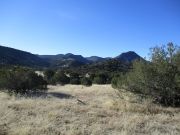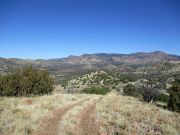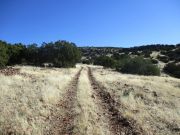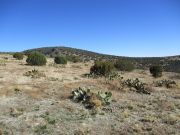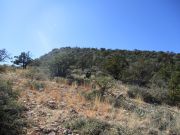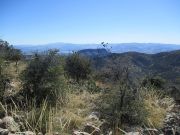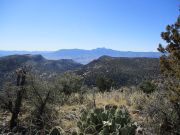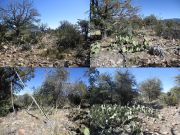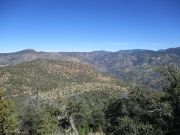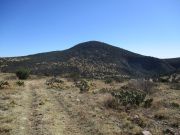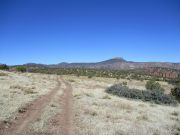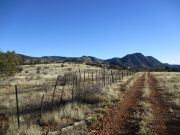
The Mountains of Arizona
• www.surgent.net
|
| Chubb Mountain & Peak 5515 |
• Sierra Ancha • Tonto National Forest • Salome Wilderness • Gila County |
|
Date: February 12, 2022
• Elevation: 5,758 feet
• Prominence: 1,078 feet
• Distance: 13.4 miles
• Time: 8 hours, 10 minutes
• Gain: 2,266 feet (gross)
• Conditions: Excellent
• Teammate: Matthias Stender
• Prog Rock bands played: Accordo del Contrari, Stratus Luna, Moraine
Arizona
•
Main
•
AZ P1K
•
PB
•
LoJ
Chubb Mountain is in the Sierra Ancha, the mid-level of mountains below the higher peaks to the east, and above the Tonto Basin and Lake Roosevelt to the West. The summit is almost 2,000 feet lower than Armer Mountain, which rises to the east, and over 3,000 feet higher than Lake Roosevelt. The peak lies on Tonto National Forest land, but a ranch lies in the valley below and blocks the one good road access to the peak. We would have to park outside this property and go around it.
Matthias and I have been kicking this peak around now for awhile, waiting for the right time to hike it. It would be too cold and possibly with snow (and mud) in the dead of winter. We waited for the first warm spell of the year, 80s in the Phoenix area, which meant 60s and 70s at the mid elevations. It's been dry for weeks so there would be no chance of remnant snow (and mud).
We met at the Target on Shea Boulevard in Fountain Hills before dawn. We drove north up the Beeline (AZ-87) to highway AZ-188, southeast toward Punkin Center, where we would get onto Forest Road 71 that leads into the mountains. This road has to ford Tonto Creek, and it was flowing today like it always does, but the deepest of the channels was only a few inches, we got through it fine. Another 14 miles later, we were at the gate of the Greenback Ranch, which lies in the Greenback Valley, hemmed in on the west by Boneyback Peak and on the east by ridges that lead toward Chubb Mountain.
The road splits immediately before the ranch, the right gate shut, but the left one open. You have to get out and look to see the "no trespassing" sign on the open gate. We stayed outside, and decided to go look at FR-236 about a half-mile back. It heads northeast but intersects a rough Jeep track that goes south atop the ridges toward Chubb. This was Plan B. FR-236 was pretty good at first, then very rocky where it crosses Greenback Creek. We debated whether to continue. I think it came down to that it would be the same amount of time whether we hiked or drove, and we knew the hiking route would (should) work, so we want back to the gate.
We started hiking at 8:30 a.m., temperatures cool but pleasant, the sky clear and blue. The map shows a track that is ostensibly on the ranch property, but only briefly before swinging back north onto Forest property. The gate was open. So we decided to take a small chance and walk the main ranch road in about a quarter mile to this secondary road, then follow it back north and off the property. This worked well and is exactly what happened. Interestingly, where the roads intersect, there is another gate, this one closed, that leads deeper onto the property. Our guess is that the first gate is left open as an easement for people needing to access that secondary forest road. There would be no reason to go past the second gate unless you had actual business on the ranch. So technically, we were on the ranch property for about ten minutes, then once off it, we were on Forest property the remainder of the hike.
The road bent right, heading east, then a few minutes later, intersection another road, not shown on the map. This road hung closer to the north boundary fence of the ranch. We had to pass through a gate here. This road devolved into a rough and rocky path, dropping into the main channel of Greenback Creek, which we followed for about a hundred yards in the soft sand. It left the channel, gaining steeply up an eroded segment onto a hill. Now on the hillside, we had more grass and scattered pinon and juniper, and a cow. So far, we'd hiked a mile, things were going well.
In this grassy field, the track is barely discernible. There is a Y-junction here, a right goes south and a left goes east toward a very steep set of switchbacks. My assumption is that we'd go left and gain the ridge sooner, while Matthias assumed we'd go right and gain the ridge about a mile to the south. The track looked better to the right, so we kept with it. It is not shown on the map, but it can be seen on the satellite images. At times, the track is just a few feet wide, extremely rocky, and suitable for an ATV at best. It likely never sees a vehicle. But for walking, it worked fine. It stayed mostly within or near Greenback Creek.
The track then started to angle west toward the ranch. We didn't want to do that, so we left the track and went cross country for a little less than a mile. We wanted to catch the track again (shown on the topographic map). Between us and the track were a couple of drainages, with steep sides and heavy brush, and all the fun kind like catclaw, holly and dense and tangly mountain oak, and prickly-pear cactus. We got through this, but it slow going. Between the drainages was sloping hillside of grass and light forest, all very pretty. Finally, we spotted the track and soon got to it. We were elevated a little and had a nice view of the ranch property, now southeast of it.
The track now was a decent road, a Jeep could handle it easily. It did not have any large rocks or bad leans. For walking, it was fantastic. For the first time, we were making excellent upward progress. Within minutes, we were on top the ridge, here an open meadow, with a couple water troughs and four cows. They watched us, then went to drink from the troughs. We just walked past them. This ridge track is the one I mentioned earlier. It goes south to Chubb Mountain, and north to connect with FR-236. We headed south. Matthias said the peak was just two miles on a straight line.
The track wandered through more meadow, then into the low forest, getting rockier and looser as it steepened to gain a pass between two hills, the one on the right with cliffs facing us. This pass is northwest of Chubb Mountain about a mile, and a little less than a mile west of Peak 5515, which is north of Chubb Mountain. We debated what to do. If we stayed on the track, it drops about 200 feet, meaning we would have to bust up about 700 feet to tag Chubb Mountain's summit. Or we could go visit Peak 5515 first, tag it, then drop to the saddle between it and Chubb, and hike up Chubb Mountain from there. We both wanted to visit Peak 5515 anyway as our day's "bonus peak". So we went that way.
The hike to Peak 5515 went well. We gained elevation slowly, angling upward along a long ridge through increasingly-dense brush, requiring us to find ways through the barriers. But it was a simple hike and we were at the top quickly. The top of Peak 5515 is gently rounded and hard to discern a single highest point. The trees and cactus were too thick to permit open views. We didn't spend long here anyway. It wasn't an exciting summit, but it counts.
We then headed down Peak 5515 toward the saddle north of Chubb Mountain. There were no surprises here. Only a few times did we have to stop and figure a way through the crud. There was a surprising amount of prickly-pear cactus, sometimes growing so close to one another that there is no way through it. You never "push through" prickly-pear cactus, or any cactus for that matter. Always go around. I got stung once by a prickly pear. The big needles, those hurt but not too bad. They're big and easily removed. But it's the five dozen little hair-like needles that hurt the worst. They go right through denim, they're as fine as hair, and pulling them out is difficult. I should have brought some duct tape with me. My shins are still red from all the little stings from them.
From the saddle, we started uphill toward the top. We stayed mostly left, near the big drops to the east, alongside some big rocks. This was not by design. It just looked like a good way to go. It was thick and dense at times, but soon, everything opened up, relatively speaking. We had more open slope, sometimes less trees, and it was easy to spy lanes through the rocks and brush. Thus, this final 200-foot push was easy and went fast. We were soon on top of Chubb Mountain. Victory was ours.
Unfortunately, Chubb Mountain's summit wasn't much better than Peak 5515. It was gently rounded, enough trees to block views, and thick prickly-pear. We found the register and signed in, the first people here since 2016. It only held a handful of names going back to 2004, the ones we usually see. There are openings around the summit area to get decent views of the surrounding peaks and canyons. I got an image of Dutchwoman Butte which we climbed four months ago. The waters of Lake Pleasant could be seen through openings between the foreground peaks. Four Peaks rose to the west, still some snow on its highest slopes. We spent about 15 minutes up here.
On the hike down to the saddle, the trees would randomly open up and we had astounding views north and east into the Salome Canyon Wilderness and its giant cliffs. The day was crystal clear with no humidity. Peaks on the highest skyline were plainly visible, including their shadows. The sun was now past zenith and just west enough to create lovely shadows on the cliffs fronting Armer Mountain to the east.
We hiked down to the track, which meant we had to gain back 200 feet to get to the higher pass, where we had been earlier before we hiked to Peak 5515. Then we hiked down and back to the junction of the tracks where we had come up. The cows were long gone by now. We agreed that we would exit by staying high on the ridge and taking those steep switchbacks down, rather than go low and have to deal with those drainage crossings.
This portion went fine. We had to gain about 150 feet but it was a gentle rise, getting us around one hill along the ridge. The track was occasionally smooth enough a Prius could drive it, and at other times, rocky enough to where only a Jeep could handle it. In about two miles from the cattle troughs (almost 4 from Chubb Mountain), we came to where the side road that goes down those steep switchbacks should be ... but it wasn't there. It was just a lot of grass. Then Matthias saw two plastic markers, and it was the road. The markers stated the road was shut to vehicles. We hiked down anyway. The tracks were awful, completely decayed and rutted, with channels about three feet deep in places, and very loose. We got to the bottom and took a break. I was very thirsty by now, and really lagging.
I was having an issue with my new hiking boots. This was the first big hike with them. It's a brand that always works well for me. My left foot kept sliding forward and pushing my toes against the insides. Over time, it was becoming very sensitive. The boots just need some breaking in. But combined with the steep slopes, the loose rocks and my fatigue by now, I was moving slowly and being careful with my feet, trying to take the downhills carefully so I wouldn't repeatedly bash my toes.
Once down off the switchbacks, we were soon at that Y-junction from this morning. In retrospect, both ways had their negatives. The low route forced us off road to avoid the ranch, and the high route meant dealing with those switchbacks, which were nasty and would have been a challenge to hike uphill. The hike out went well. I was slowing by now. Matthias beat me to the car by a couple minutes. We egressed at 4:40 p.m., an 8-hour and 10-minute afternoon. I was absolutely exhausted. Matthias said we'd hiked 13.4 miles. That would explain a lot. That's the longest I've hiked in over 4 years. While most of it was along a track, the off-track portions sometimes went slow, and some of the track sections went slow too. It was a hard-earned peak.
We got changed and drove out, getting back into Fountain Hills as the sun was setting. We shook hands and parted ways, another fine day in the wilderness. I stuck around to get the taco dinner at Señor Tacos, which adjoins the Circle-K gas station across from the Target. I needed some tacos to recuperate. They're high in vitamin-T.
Studying the satellite images afterwards, when we were on the track within Greenback Creek on our ascent, had we stayed on it, it would have veered back to the ranch fenceline, but then another track heads south and connects to that good road we took up to the high ridge. We would have avoided having to cross drainages, and I don't recommend the switchback route either. I'd recommend to stay low, catch the good road both up and down, and possibly give Peak 5515 a miss unless you need to pad your ranked summits count. I made this annotated map based on Matthias' GPS route to help splain.
|
|
